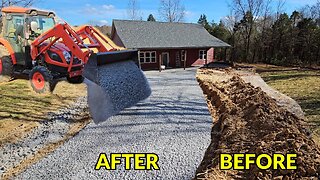A land management Case study-Deer watering hole, Kioti NX6010, trail cam evidence/pond liner project
First of all here are some video links to this original mini series of this new, deep woods, rocky ridge watering hole project. This is the video link to the original, full project video of digging this new watering hole with the bobcat e42 mini excavator:
https://youtu.be/LFKXzPFjDHs
Here is the DIY laying pond liner original project video: https://youtu.be/d2mrpOWo8LE
Here is another video of building this watering hole:
https://youtu.be/p8wB5Lqo5zw
Now for today's land management case study and follow up video. Let's take a look back at this new watering hole experiment that I did on our Southern Illinois hunting land to do some wildlife conservation upgrades and wildlife conservation project experiments. Back in 2017 this was another wildlife watering pond (aka deer watering hole) experiment that I did with my bobcat e42 mini excavator, in an area that by all rights, could not have held year round water. There are many reasons that I am continually adding year round watering ponds for wildlife on our home farm in Southern Illinois as well as any investment properties that we invest in. First, the most obvious is to provide a year round watering source to deer and other wildlife. We live in the 'mid south' here and in hill country, so all of our 'creeks' are actually just water runoff ditches that will dry up for months at a time. And as a back up plan I located watering holes next to food plots to provide a backup plan, or 'plan B' for my food plots so that I can use the watering ponds (if they are big enough) to water the food plots in the case of an extended drought. So today's project was quite challenging in many ways, but just to mention a few; A) it was on top of a rocky ridge, very porous, so the dirt would not hole water, B) there were a lot of large rocks and stones the remove just to get a shallow watering hole, and C) it was in very tight spacing for the bobcat mini excavator, so it was challenging just to get the mini excavator in there, even though I had to avoid hitting trees while I dig and swing the boom around. And then, of course, my first attempt at this watering hole with a pond liner I made some mistakes so it ended up only staying maybe half full. Then I went back in for part 2, or plan B, to add some more pond liner materiel to the original watering hole to try to make it larger and to hold more water to improve it's longevity. Then we'll get a follow up trail cam video montage of deer and other wildlife using the newly created watering source. Needless to say I picked a great location for this new watering pond!
Here at Kapper Outdoors we enjoy living the dream every day in the woods and constantly working on our property and others' properties and share so many ways of Improving your property, Illinois land management projects, Fall food plots and brassica food plots for deer 2021, deer watering holes, and many other wildlife habitat improvement projects. Any ways, thank you for joining us today and as always if you enjoy this video please hit the like button and share it for us, as we would greatly appreciate the help in growing our YouTube channel and smashing through that 100,000 subscriber count! Also, consider subscribing to follow all of our Southern Illinois and Western Kentucky land management projects, food plots, duck ponds, watering ponds, deer watering holes, deer habitat improvement projects, wildlife conservation projects, Bobcat e42 R series mini excavator projects, land clearing projects, Kioti RX7320 tractor projects, Bobcat T650 CTL skid steer projects, old barn demolitions, barn picking, barn wood salvaging, DIY rustic barn wood projects, DIY rustic red cedar projects, DIY rustic farmhouse décor projects, DIY rustic wood furniture projects, some hunting, fishing, exploring and much more country living adventure! Thank you. Kapper Outdoors, living the dream, one acre at a time.
-
 10:49
10:49
Everything land, outdoors & property!
6 months ago $0.02 earnedWill it hold? Building a gravel driveway without a base layer-Kioti NS6010 & TR3 tractor rake
175 -
 19:28
19:28
Stephen Gardner
6 hours ago🔴BREAKING: Biden’s RECKLESS new scheme fails with the PEOPLE!!
2.33K18 -
 1:03:16
1:03:16
Kimberly Guilfoyle
2 days agoSlow Joe Hits a New Low, Plus New Case of Illegal Immigrant Crime, Live with Karoline Leavitt & Sen Tommy Tuberville | Ep. 134
63K79 -
 2:35
2:35
Random Food
4 days ago $0.32 earnedMixed Berry with Lemon Cream Biscuits
9183 -
 59:15
59:15
Son of a Boy Dad
2 hours agoNew York vs. LA | Son of a Boy Dad #210
7021 -
 24:00
24:00
Bare Knuckle Fighting Championship
20 hours agoRoad To BKFC 62
1.25K -
 48:57
48:57
Plan Bri Uncut
1 hour agoSo Classic | PlanBri Uncut Episode 265
7151 -
 7:01
7:01
Evenout
17 hours agoTIME TRAVELLER TWIN PRANK💀🤯
1.03K -
 5:22
5:22
ThinkStory
1 day agoDARK MATTER Episode 8 Breakdown, Theories & Details You Missed!
1.22K3 -
 22:03
22:03
TheTapeLibrary
23 hours ago $0.26 earnedUncovering the TRUTH of the Serbian Dancing Lady
1.56K1